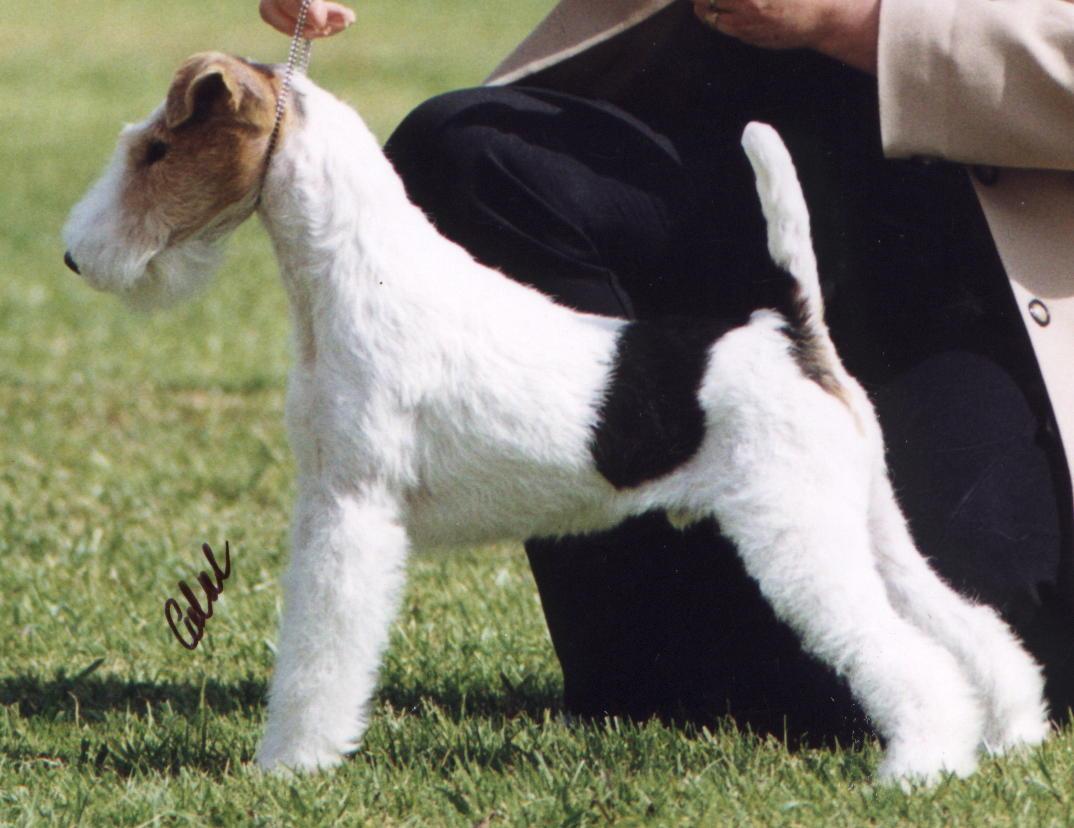
Kennel Club, London 1994
F.C.I. Standard No 169
GENERAL APPEARANCE -
Active and lively, bone and strength in small compass,
never cloddy or coarse. Conformation to show perfect
balance, in particular this applies to the relative proportions
of skull and foreface, and similarly height at withers and
length of body from shoulder-point to buttocks appear
approximately equal. Standing like a short backed hunter
covering a lot of ground.
CHARACTERISTICS -
Alert, quick of movement, keen of expression, on tiptoe
of expectation at slightest provocation.
TEMPERAMENT -
Friendly, forthcoming and fearless.
HEAD AND SKULL -
Topline of skull almost flat, sloping slightly and gradually
decreasing in width towards eyes. Little difference in
length between skull and foreface. If foreface is noticeably
shorter head looks weak and unfinished. Foreface gradually
tapering from eye to muzzle and dipping slightly at its
juncture with forehead but not dished or falling away quickly
below eyes where it should be full and well made up.
Excessive bony or muscular development of jaws undesirable
and unsightly. Full and rounded contour of cheeks undesirable.
Nose black.
EYES -
Dark, full of fire and intelligence, moderately small, not
prominent. As near circular in shape as possible. Not too far
apart nor too high in skull nor too near ears. Light eyes highly
undesirable.
EARS -
Small, V-shaped, of moderate thickness, flaps neatly folded
over and dropping forward close to cheeks. Top line of folded
ears well above level of skull. Prick, tulip or rose ears highly
undesirable.
MOUTH -
Jaws strong with perfect, regular and complete scissor bite,
i.e. upper teeth closely overlapping the lower teeth and set
square to the jaws.
NECK -
Clean, muscular, of fair length, free from throatiness,
broadening to shoulder, presenting a graceful curve when
viewed from side.
FOREQUARTERS -
Seen from front, shoulders slope steeply down from junction
with neck towards points which should be fine; viewed from side,
long and well laid back and sloping obliquely backwards. Withers
always clean cut. Chest deep, not broad. Viewed from any
direction, legs straight, bone strong right down to feet. Elbows
perpendicular to body, working free of sides, carried straight
when moving.
BODY -
Back short, level and strong without slackness, loin muscular,
slightly arched. Brisket deep front ribs moderately arched,
rear ribs deep, well sprung. Very short coupled.
HINDQUARTERS -
Strong, muscular and free from droop or crouch. Thighs long
and powerful. Stifles well bent, turning neither in nor out.
Hocks well let down, upright and parallel when viewed from rear.
Combination of short second thigh and straight stifle highly
undesirable.
FEET -
Round, compact with small, tough and well cushioned pads, toes
moderately arched. Turning neither in nor out.
TAIL -
Preferably docked. Set high, carried erect not over back nor
curled. Of good strength and fair length.
GAIT/MOVEMENT -
Fore and hind legs move straight forward and parallel. Elbows
move perpendicular to body, working free of sides. Stifles turning
neither in nor out. Good drive comingfrom well flexing hindquarters.
COAT -
Dense, very wiry texture, & 3/4; in on shoulder to 1 & 1/2; in on
withers, back, ribs and quarters with undercoat of short, softer hair.
Back and quarters harsher than sides. Hair on jaws crisp and of
sufficient length to impart appearance of strength to foreface.
Leg hair dense andcrisp.
COLOUR -
White predominates with black, black and tan or tan markings.
Brindle, red, liver or slate-blue marking undesirable.
SIZE -
Height: Dogs not exceeding 39 cms (15 & 1/2; ins) at withers
Bitches slightly less
Ideal weight Dogs in show condition 8.25 kg (18 lbs);
Bitches slightly less.
FAULTS -
Any departure from the foregoing points should be considered
a fault and the seriousness with which the fault should be regarded
should be in exact proportion to its degree.
NOTE -
Male animals should have two apparently normal testicles fully
descended into the scrotum.
Terrier Group A.N.K.C. © January 1998



